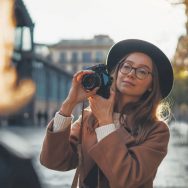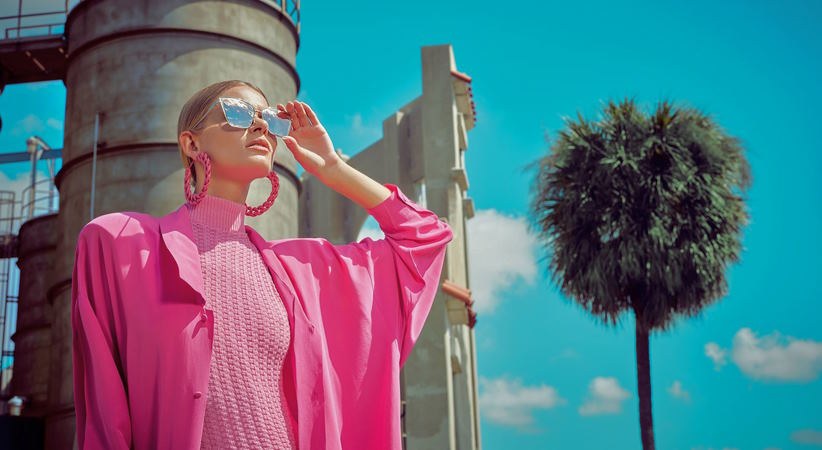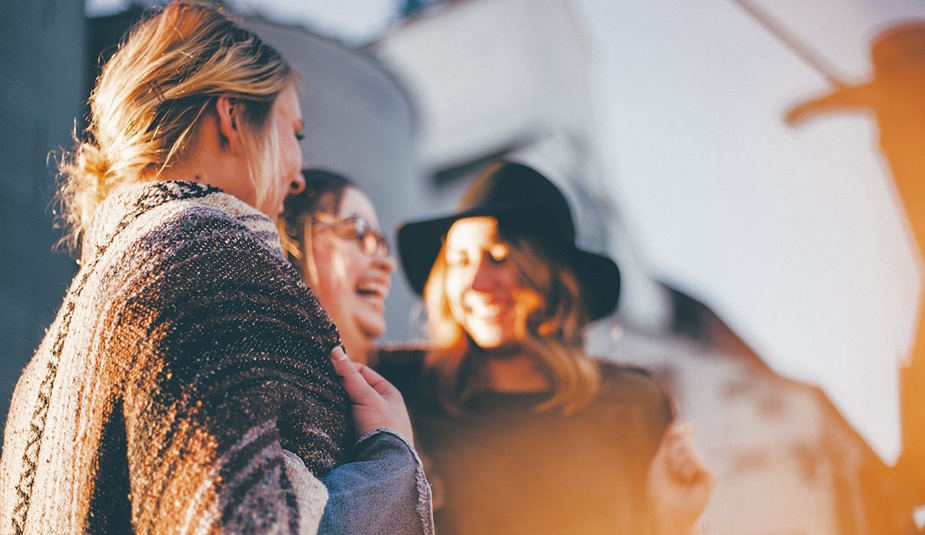Shooting Fashion Photography in Different Weather Conditions
Posted on Oct 21, 2022 in Photos for Fashion Brands

Welcome to the world of fashion photography, where creativity and adaptability are key. As a fashion photographer, you’re no stranger to capturing stunning images in ideal weather conditions with perfect lighting. But what happens when Mother Nature decides to throw a curveball and presents you with challenging weather conditions? Rain, snow, wind, or extreme heat can disrupt your plans and put your photography skills to the test. But fear not! In this blog post, we will explore the exciting world of shooting fashion photography in different weather conditions, and learn how to overcome the obstacles posed by Mother Nature. Whether it’s embracing the rain for a moody shoot, harnessing the power of wind for dynamic poses, or working with the soft light of a snowy day, we’ll dive into the techniques and tips that will help you capture stunning fashion photos, no matter what the weather has in store. So, grab your camera, put on your raincoat or snow boots, and let’s explore the art of shooting fashion photography in any weather condition!
Shooting Fashion Photography in Rainy Weather
Rainy weather can present unique challenges for fashion photography, but with the right techniques and creativity, it can also offer exciting opportunities for unique and captivating shots. In this section, we will discuss how to protect your gear from rain damage, find creative opportunities in rainy weather, and consider lighting considerations for shooting in overcast or low-light conditions. We will also analyze the impact of fashion photography in rainy weather with examples.
Protecting Gear from Rain Damage
Protecting your photography gear from rain damage should be a top priority when shooting in rainy weather. Here are some tips to keep your gear safe:
- Use rain covers: Invest in high-quality rain covers for your camera body and lenses. These waterproof covers can protect your gear from moisture, ensuring that it remains dry and functional.
- Keep a towel handy: Have a towel or a microfiber cloth on hand to quickly wipe off any raindrops that may get on your gear. Be sure to dry your gear thoroughly to prevent water damage.
- Use an umbrella: Consider using a large umbrella to create a makeshift shelter for yourself and your gear during the shoot. This can help keep your gear dry while allowing you to shoot in the rain.
Finding Creative Opportunities in Rainy Weather
While rain can be challenging, it can also provide creative opportunities for fashion photography. Here are some tips to make the most of rainy weather:
- Look for reflections: Rainy weather creates puddles and wet surfaces that can be used to create interesting reflections. Experiment with shooting models’ reflections in puddles or capturing the reflection of lights and colors in the wet streets.
- Capture unique textures: Rain can add a sense of drama and texture to fashion photography. Look for interesting textures created by raindrops on surfaces, such as glass windows or leaves, and use them to add depth and visual interest to your shots.
Lighting Considerations and Techniques for Rainy Weather
Rainy weather often means overcast or low-light conditions, which can impact the lighting in your fashion photography. Here are some considerations and techniques to keep in mind:
- Use diffused light: Rain clouds can act as natural diffusers, softening the light and creating a flattering, even illumination. Take advantage of this soft light to capture moody and atmospheric shots.
- Consider artificial lighting: If the natural light is too dim, consider using artificial lighting, such as continuous lights or off-camera flash, to add light to your subjects and create a desired mood.
Examples of Fashion Photography in Rainy Weather
Rainy weather can add a sense of drama, emotion, and uniqueness to fashion photography. Here are some examples of fashion photography shot in rainy weather and their impact:
- A model posing with an umbrella in the rain, creating a sense of mystery and intrigue with the contrast between the model’s elegance and the rawness of the weather.
- A fashion shoot with models wearing vibrant raincoats and colorful umbrellas, adding a pop of color against the gray backdrop of rainy weather, creating a striking visual contrast.
Shooting fashion photography in rainy weather may come with its challenges, but with careful gear protection, creativity in finding opportunities, and consideration of lighting techniques, it can result in stunning and impactful shots. Embrace the rain, experiment with different techniques, and capture the beauty that rainy weather can offer to elevate your fashion photography to new heights.

Shooting Fashion Photography in Sunny Weather
Sunny weather can offer beautiful lighting and vibrant colors for fashion photography, but it also comes with its own set of challenges. In this section, we will discuss how to handle harsh sunlight and shadows, manage heat and sweat during outdoor shoots, consider lighting considerations, and techniques for shooting in bright sunlight, and analyze the impact of fashion photography in sunny weather with examples.
Handling Harsh Sunlight and Shadows
Harsh sunlight can create harsh shadows and highlights, which can be challenging to manage in fashion photography. Here are some tips to handle harsh sunlight and shadows:
- Use open shade: Look for areas with open shade, such as under a tree or a building, to diffuse the harsh sunlight and create soft, even lighting on your subjects.
- Use a diffuser: Consider using a diffuser, such as a translucent fabric or a portable photography reflector, to soften the harsh sunlight and create more flattering lighting on your subjects.
- Adjust exposure: Be mindful of the exposure settings on your camera to avoid blown-out highlights or deep shadows. Experiment with exposure compensation to get the right balance between shadows and highlights.
Managing Heat and Sweat during Outdoor Shoots
Shooting in sunny weather can also mean dealing with heat and sweat, which can affect both you and your models. Here are some tips to manage heat and sweat during outdoor shoots:
- Stay hydrated: Make sure to drink plenty of water and stay hydrated throughout the shoot. Bring extra water bottles for both yourself and your models to keep everyone refreshed and comfortable.
- Use a makeup setting spray: Consider using a makeup setting spray on your models to help their makeup last longer and prevent it from melting off in the heat.
- Dress appropriately: Choose lightweight and breathable clothing for yourself and your models to stay comfortable in the heat. Avoid dark colors that can absorb heat and make you feel hotter.
Lighting Considerations and Techniques for Sunny Weather
Bright sunlight can offer unique opportunities for fashion photography, but it also requires careful consideration of lighting techniques. Here are some lighting considerations and techniques for shooting in bright sunlight:
- Use reflectors: Utilize reflectors to bounce sunlight onto your subjects and fill in shadows. Silver or white reflectors can create a natural-looking fill light and reduce harsh shadows.
- Use fill flash: Consider using fill flash to balance the exposure and fill in shadows created by harsh sunlight. Use a diffuser on your flash to soften the light and create a more natural look.
Examples of Fashion Photography in Sunny Weather
Sunny weather can create stunning fashion photography with vibrant colors and dynamic lighting. Here are some examples of fashion photography shot in sunny weather and their impact:
- A model posing in a bright yellow dress against a blue sky, creating a bold and eye-catching image with contrasting colors that evoke a sense of energy and warmth.
- A fashion shoot with models wearing sunglasses and showcasing summer outfits, capturing the essence of the season with the bright sunlight and creating a sense of fun and playfulness.
Shooting fashion photography in sunny weather requires careful consideration of lighting, managing harsh sunlight and shadows, and dealing with heat and sweat. By utilizing techniques such as diffusers, reflectors, and fill flash, and taking care of yourself and your models, you can create stunning fashion photography in sunny weather that captures the beauty of natural light and creates impactful images.

Shooting Fashion Photography in Windy Weather
Windy weather can add an element of unpredictability and excitement to fashion photography, but it also presents challenges in dealing with hair and clothing movement. In this section, we will discuss how to deal with hair and clothing movement caused by wind, provide tips on finding creative opportunities with wind, discuss lighting considerations and techniques for shooting in windy conditions, and analyze the impact of fashion photography in windy weather with examples.
Dealing with Hair and Clothing Movement caused by Wind
One of the biggest challenges of shooting fashion photography in windy weather is dealing with the movement of hair and clothing. Here are some tips to tackle this challenge:
- Use hair and wardrobe styling techniques: Consider using styling techniques such as hairspray, bobby pins, and wardrobe tape to help control the movement of hair and clothing. Opt for clothing that fits snugly or has weight to minimize excessive movement.
- Embrace the movement: Instead of trying to completely eliminate hair and clothing movement, embrace it as a creative opportunity. Experiment with dynamic poses that work with the movement of the wind, and capture the natural flow and energy it adds to the images.
- Shoot in bursts: Use continuous shooting mode on your camera to capture multiple frames in quick succession, increasing the chances of getting a shot with minimal hair and clothing movement.
Finding Creative Opportunities with Wind
Windy weather can offer unique creative opportunities for fashion photography. Here are some tips on how to make the most of the wind in your images:
- Use props: Utilize props such as fabric, scarves, or ribbons that can catch the wind and add movement and drama to your images. Play with different fabrics and see how they interact with the wind to create dynamic and visually appealing shots.
- Experiment with poses: Encourage your models to experiment with dynamic poses that work with the movement of the wind. This could include poses that show movement and flow, such as walking or twirling, to add a sense of energy and drama to the images.
Lighting Considerations and Techniques for Windy Weather
Shooting in windy conditions can also affect lighting considerations and techniques. Here are some tips to consider:
- Use continuous lights: Consider using continuous lights, such as LED panels or video lights, that provide a constant source of light even in windy conditions. Continuous lights can help you maintain consistent lighting on your subjects, despite the movement caused by the wind.
- Adjust shutter speed: Use faster shutter speeds to freeze the movement caused by wind and prevent motion blur in your images. Experiment with different shutter speeds to find the right balance between freezing movement and maintaining image sharpness.
Examples of Fashion Photography in Windy Weather
Fashion photography in windy weather can create stunning and dynamic images. Here are some examples and their impact:
- A model wearing a flowy dress with fabric billowing in the wind, creating a sense of movement and freedom. The wind adds a dynamic and ethereal quality to the image, evoking a sense of grace and elegance.
- A fashion shoot with a model posing with a prop, such as a flowing scarf or a flying umbrella, capturing the playful and dynamic nature of the wind. The movement of the prop adds a sense of drama and visual interest to the images.
Shooting fashion photography in windy weather requires managing hair and clothing movement, finding creative opportunities with the wind, and considering lighting techniques. By embracing the movement, using props, experimenting with poses, and adjusting lighting settings, you can create impactful fashion photography that captures the energy and drama of windy weather.

